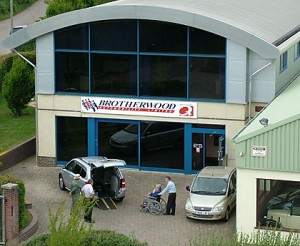 Leafing through the first copy of Disability View from 1994 – the magazine that became Able, we happened upon an advert from a company that still supports the publication to this day. Brotherwood Automobility, based in Dorset. We asked Rod Brotherwood how things have changed in the past 20 years.
Leafing through the first copy of Disability View from 1994 – the magazine that became Able, we happened upon an advert from a company that still supports the publication to this day. Brotherwood Automobility, based in Dorset. We asked Rod Brotherwood how things have changed in the past 20 years.
From Able Magazine #109 (January/February)
So we’ve been showcasing your advertising for 20 years, so you must be even more established than we are…
It’ll be 30 years in 2015 but really every year’s an anniversary.
Marketing was different when we first started, 20 years ago.
We have always supported the (disability) media. When I started you must remember it was before websites etc, the most common way of marketing was probably through the ‘Yellow Pages’ and in magazines. I’m a very, very strong believer of letting people know that we’re here.
How have perceptions and expectations changed regarding disability motoring?
I moved next door to a guy who was quadriplegic (30 years ago) – injured in a motorbike accident and he asked me if I could build a car for him because he was using a van with a tail lift. There wasn’t really enough room to get through the back, although it was a large van and then when he was inside, his head was resting on the roof. Basically, the vehicle that he had was a large van with windows stuck in the side.
So, I drew up an idea I had for him after listening to what he wanted, and that was the very first Nissan Prairie. This was with a lowered floor that allowed him to sit very close to the driver and the front passenger. It’s surprising even today that people say “well, we didn’t realise there were vehicles like this”.
There’s actually a picture of it in the first advert you ran in Able Magazine.
I got the car back after five owners had used it and it sat here in the showroom again. We used it a couple of times at exhibitions as a centrepiece.
What kind of industry changes have you seen in the past 20 years?
I realised in the early 1990’s that there was no regulation of the industry, and coming from an aircraft background, I felt that that wasn’t fair on disabled people and that they should be entitled to exactly the same safety considerations as everybody else when travelling in a car. It was about equality.
We were the first people to convert ordinary M1 class vehicles such as the Nissan Prairie etc. There were still an awful lot of vans being converted well into the 1990’s – where they’d cut the sides out, put windows in and a carpet on the floor but still with no regulation. So we sorted out a tie up with Volkswagen on the Sharan and that became the first vehicle to go through type approval; that involved establishing a testing progamme for the vehicles.
Gradually the other converters joined in and in 1999 we formed WAVCA with five other converters and I wrote out what was effectively our code of practice.
There was no standard either, so I wrote it out and established the different areas about how the work should be done and what people could expect in terms of safety. Motability picked this up and it became the Motability standard. Surely if somebody is laying out good money for a vehicle that’s modified, it should be done to a standard.
You’ve literally seen it all, so what do you think might be on the horizon?
There’s much more choice now and this is the result of strong competition. Once you’ve got competitors in there vying for trade, that raises the standard as well.
I would think that the next revolution for disabled drivers and passengers in a suburban context is probably going to be the use of electric vehicles. Most of our customers use electric wheelchairs anyway and are used to the regime of keeping the batteries charged as everyone does with their mobile phones nowadays.
We’ve had the biggest growth in the world in wheelchair accessible vehicles over the last 25 years, mainly driven by the Motability Scheme. It’s an amazing scheme to get disabled people mobile. There is no other country where disabled people are funded in the same way.
It is all moving forward.
More: Brotherwood



